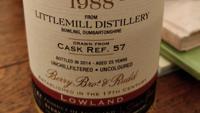Chill Filtration
Contents

‘Non chill-filtered’ the term sounds good on the label of a whisky bottle. And many whisky connoisseurs are firmly convinced that an unfiltered single malt is the way it should be. But what exactly happens with the chill-filtration of whisky? And do unfiltered whiskies really taste better?
Are ‘non chill-filtered’ whiskies better than chill-filtered whiskies?
The general consensus is that from a purely taste perspective the impact is so small as to be unnoticible in a blind tasting. However the absense of oils and fats within the whisky will certainly change the mouthfeel.
What is chill-filtration?
In chill-filtration, the whisky is cooled down to a low temperature before being bottled. At 0° Celsius or slightly below, the liquid is then pumped through a very fine filter. This is intended to filter suspended particles and residues from the distillation from the whisky.
Why is whisky chill-filtered?
Most Scotch whiskies are bottled with less than 46% alcohol. If you now add water or ice to the whisky, it can become cloudy (it is also called whisky haze). This phenomenon does not occur with higher percentage bottlings.
Three factors can cloud the whisky:
- Long-chain fatty acids and large ester molecules were created during the production of the whisky (the food chemist you trust will be happy to give you the exact details) bored for several hoursentertained enthusiastically). At low temperatures, these substances become visible as streaks or cloudiness in the whisky.
- During the storage of the whisky, various wood extracts (lipids and long-chain fatty acid esters) and microscopic floating particles (coal or wood particles) can detach from the oak wood and cloud the liquid.
- The spring water, which is used to dilute the whisky to, for example, 40% alcohol content, can contain calcium salts (so-called calcium oxalates). These very small crystals can also become visible and cloud the distillate. That is why the water is often demineralized before it is added to the whisky.
The described clouding of the whisky is completely harmless to health and could be left as is in the bottle.
The Marketing Issue
However, let us assume that an inexperienced customer who is not familiar with these effects is standing in front of the whisky shelf in the shop. They see a cloudy whisky bottle, or having already bought the bottle and finds that the whisky is clouded over at home after work with ice. That they consider something wrong with the whisky is exactly what the whisky manufacturers want to avoid. Their product should be so clear and unchangeable in the bottle that there is no doubt about the quality. The whisky is therefore chill-filtration exclusively for aesthetic and cosmetic reasons and not for aromatic reasons.
Are flavors filtered out of the whisky? Well, no one has anything against a clear, brilliantly radiant whisky in the glass. Wouldn’t it be the big worry that many whisky connoisseurs are concerned with: What if flavors are also removed from the whisky during chill-filtration? When the texture and mouthfeel of the whisky are affected?
Clarification could best provide a blind tasting of various filtered and unfiltered whiskies. The German whisky evangalist Horst Lüning carried out exactly such a tasting in 2014. The astonishing result, even tasting experts could hardly taste the differences between chill-filtration and non-chill-filtration whiskies. The testers also liked the ‘non chill-filtered’ whiskies no better than their filtered counterparts.
So whether a whisky is filtered or not is not a big difference for us connoisseurs: the differences in taste are minimal at best. Already the alcohol strength of the bottling makes a difference - because many unfiltered malts also have more percent or are cask strength whiskies.
And yet there remains an uneasy feeling: Whisky should be traditional, natural and authentic on the one hand, but on the other hand it is heavily filtered shortly before bottling. It doesn’t really fit together.
It is similar with the coloring of the whisky with caramel (E150), which should give the distillates a stronger color and compensate for differences in the natural tint. Here too there are cosmetic reasons - you really don’t really need the dye.
Many smaller distilleries do not filter their whiskies Interestingly, it is mainly smaller distilleries and independent bottlers who do not have their whisky chill-filtered. In contrast, large brands use the method almost consistently. One reason could be that the smaller brands with their malts are more aimed at whisky connoisseurs who appreciate unfiltered quality. Distilleries that we know do not filter their whiskies consistently include:
- Ardbeg
- Arran
- Bruichladdich
- Bunnahabhain
- Deanston
- GlenAllachie
- Ledaig
- Longmorn
- Tobermory
- Port Charlotte
- Wolfburn
The topic is a hot topic among whisky enthusiasts - the casual drinker, on the other hand, will generally not care whether his Glenfiddich or Macallan has been filtered or not. Regardless the trend seems to be pointing in a different direction: Distilleries such as Auchentoshan or Aberlour now also have their first unfiltered bottlings, the more people discuss the topic and consciously perceive it when making a purchase decision, the more likely the whisky industry will move.
Previous

